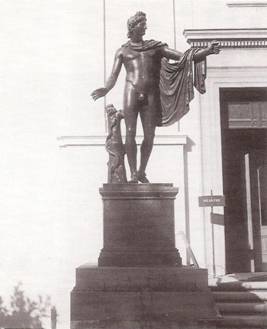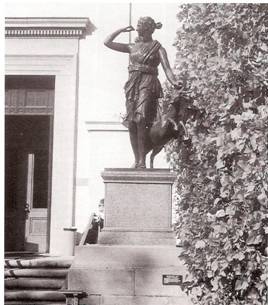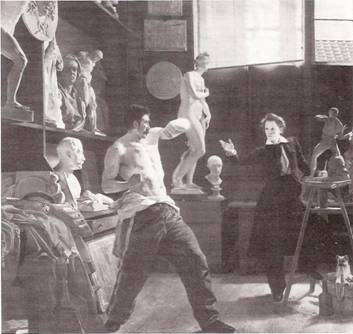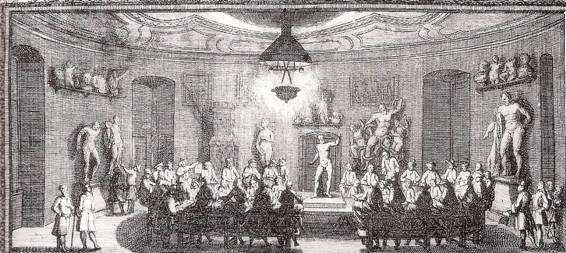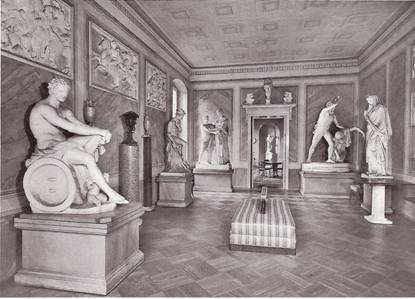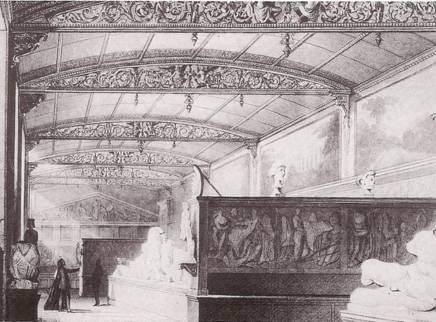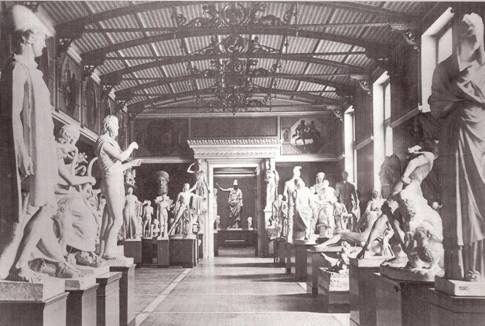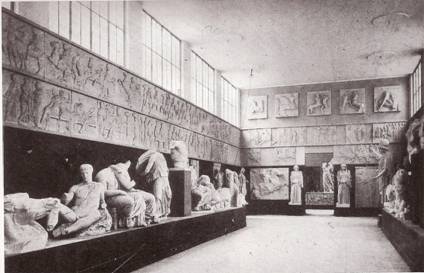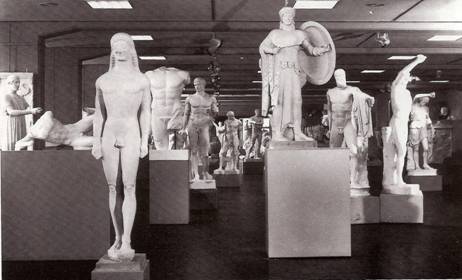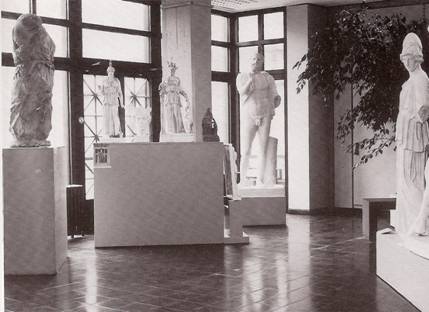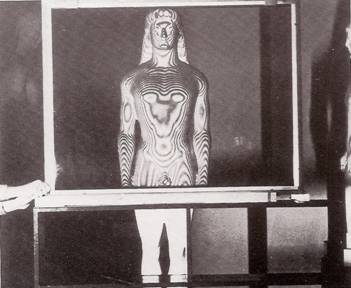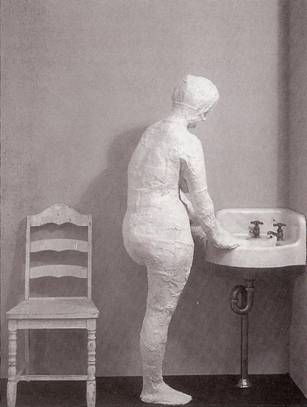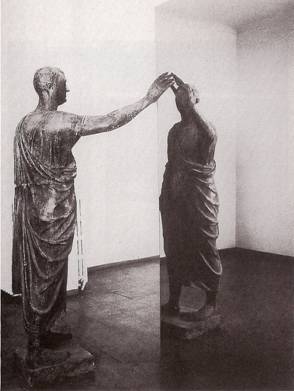Digital Sculpture Project: Casts
On the History of the Appraisal and Use of Plaster Casts of Ancient Sculpture (especially in Germany and in Berlin)
By Adolf H. Borbein
English translation by Bernard Frischer
Adolf H. Borbein, “Zur Geschichte der Wertschätzung und Verwendung von Gipsabgüssen antiker Skulpturen (insbesondere in Deutschland und in Berlin),” in Les moulages de sculptures antiques et l'histoire de l'archéologie. Actes du colloque international Paris, 24 octobre 1997, edited by Henri Lavagne and François Queyrel (Geneva 2000) 29–43.
[p. 29] It is well known that the manufacture, collection, and use of plaster casts, in particular casts of sculpture, has a long tradition. In recent years, this cultural tradition and the plaster casts themselves have attracted new interest, as this colloquium attests. In the decades between the twenties and seventies of this century, interest in casts was not only less developed, but the terms “plaster” and “cast” had negative connotations. In this contribution, I want to try to sketch the reasons for the changing high and low appraisal of casts and in the conclusion explain on the basis of several examples what use casts can have for contemporary archaeology. I will not produce new material but will rely on long-known facts.[1]
The technique of plaster casting was employed in ancient Egypt—here I mention only the much discussed plaster heads which were found in a workshop in the royal palace in Amarna.[2] In Egypt, as later in Greece and Rome, casts were mainly an aid for artistic practice. They facilitated the copying of statues and reliefs (in this connection we may mention the practically identical bronze herms from Mahdia and in the Getty Museum).[3] Lysistratos, the brother of Lysippus, was supposed to have invented the technique of statue casting.[4]
Casts also played an important role as models for miniature art since they could easily be transported over long distances. As examples can be mentioned the plaster casts of metal works (probably of Alexandrian origin) which were found in Begram in Afghanistan[5] as well as in Memphis;[6] and the casts of Greek masterpieces which were found in Baiae near Naples.[7] Plaster casts of living persons—an invention which was also attributed to Lysippus' brother[8]—as well as plaster or wax molds of the faces of the dead[9] also served artistic purposes. Even if they were not used as models for portraits in bronze, stone or stucco, they were at least touched up by artists and treated in the same way as, for example, terracotta sculpture. It is perhaps no accident that in recent years—that is to say at the same time when archaeologists have newly discovered the value of cast collections—research on ancient plaster casts from Amarna to Memphis, Begram and Baiae was initiated and resulted in important publications.
After the end of antiquity plaster casts became important again during the Renaissance. Just as had been the case in antiquity, they served almost exclusively as / [p. 30] elements in the process of artistic production. They were used as visual aids and study objects and occasionally also as models for copies. From the fifteenth to the nineteenth century casts of ancient sculpture belonged to the customary equipment in the studios of sculptors and painters. A few of these artists—for example, Raphael Mengs in the eighteenth century—created entire museums of casts. The Mengs collection, which contained more than 800 pieces, was purchased by the King of Saxony and made into a public museum in Dresden.[10] The academies of art, which were established starting in the second half of the sixteenth century and especially in the seventeenth and eighteenth centuries, procured casts (mainly of ancient sculpture) for their students. To draw from casts became a traditional part of artistic education, something that it has remained down to the present day.[11]
Plaster casts as components of private museums are encountered as early as the first half of the sixteenth century. The earliest preserved examples are the casts of male and female heads in the wide-ranging collection of the jurist Marco Benavides.[12] These reworked and painted heads were supposed to replace the ancient originals.
In the year 1540 the painter and architect Francesco Primaticcio was engaged by the French King François I to produce casts of famous statues in Rome, particularly in the Belvedere of the Vatican.[13] These casts served as models for bronze copies which were cast in France and that served to decorate the royal palace. Four such bronze copies from the seventeenth century are to be seen today in front of the Huntington Library in San Marino, California near Los Angeles (figs. 1, 2).[14] A century later, in 1650, another great artist, Velazquez, received from another king, Philip IV of Spain, the commission to make casts of ancient statues in Rome. And once again they were to serve as models for bronze copies to adorn the royal palace.[15]
Figure 1. Cast of the Apollo Belvedere. San Marino, California, Huntington Library (Photograph: A. H. Borbein).
We can conclude, first of all, that ancient sculpture was an important part of royal self-representation; secondly, that even kings used casts to replace originals (granting that the “royal” casts were made of bronze and not plaster); and thirdly, that there was a tendency to limit the fame and influence of ancient sculpture to a few select pieces, in particular the opera nobilia in the Belvedere. Even Winckelmann, who through his Geschichte der Kunst considerably broadened knowledge of Greek and Roman sculpture, introduced his work in Rome with a description of the famous statues in the Belvedere such as the Apollo.[16]
Figure 2. Cast of Artemis from Versailles. San Marino, California, Huntington Library (Photograph: A. H. Borbein).
In 1665 Lorenzo Bernini, who was already very famous, came to Paris in order to make a portrait of the king. On this occasion, he visited the royal academy of art, looked with little enthusiasm at the works of the members of the academy that were displayed there, and recommended to his assembled colleagues that the education of their students would be better served if the academy created a collection of casts of famous ancient statues, busts, and reliefs. Through drawing the classical models students would come to understand Beauty, and this would be useful for the rest of their life as a standard of quality. It would only hurt young people if they were confronted from the start with Nature. Nature is almost always / [p. 31] feeble and ugly. If the artist only followed Nature, then he would never be able to create something truly beautiful and great.[17]
What Bernini meant is illustrated by a picture made in 1827 by the Danish painter Wilhelm Bendz (fig. 3). A sculptor works after a living model but at the same time he corrects his model by looking at casts of ancient statues, especially the famous “Borghese ‘Gladiator’” in the Louvre, represented in his studio by a cast in reduced format.[18]
Figure 3. Wilhelm Bendz, "A sculptor works after a living model in his studio" (1827). Copenhagen, Statens Museum for Kunst (from: Kunstmuseets Arsskrift 1977–1980, 42 fig. 3).
Bernini's words could have been uttered by Johann Joachim Winckelmann—an oddity, because for Winckelmann Bernini embodied the decline of art, a decline which could only be reversed by reviving understanding of Greek art. Winckelmann's Geschichte der Kunst des Altertums appeared in 1764 and is primarily a history of sculpture. The descriptions which Winckelmann devoted to the Belvedere Apollo and Torso, sound rhetorical to our ears. Nevertheless, in terms of methodology they were a milestone in the history of sculpture. They showed something still valid today, viz. that the interpretation of a statue presumes the precise description of the object; that it must concentrate on the details without ever losing a sense of the whole and its impact on the observer.[19]
The French sculptor Étienne Falconet (1716-1791), a contemporary of Winckelmann, was convinced that a cast allows the aesthetic qualities of a statue to be more clearly recognized than does the original itself. White plaster, seen under even light, makes it easier to judge pure form. And it makes the strengths and weaknesses of the artist stand out more clearly.[20] Winckelmann designated white as the most beautiful color. According to him, a white, nude body was not only beautiful but also appeared bigger than one that was painted. In this context Wickelmann expressly mentions freshly created plaster casts, which appeared to have a greater volume than their originals.[21] In another passage Winckelmann combines the cast with Beauty: “The true feeling of the Beautiful approximates a fluid plaster which is poured over the head of Apollo and touches and embraces all its parts.”[22] People liked to view white casts illuminated by torchlight, which made them appear animated. Nighttime visits to cast collections were popular throughout the eighteenth century.[23]
Casts direct the attention of the viewer to the pure, plastic form—and down to the present day this remains one of their advantages. For this reason they were particularly prized during the baroque and neoclassical periods. Two distinct formal characteristics of the art of both epochs can be best demonstrated through casts: the pathetic gesture, which the baroque loved; and the sharp, linear contour, which was privileged in neoclassism. It was with these considerations in mind that people viewed ancient sculpture in German cast collections in the second half of the eighteenth century. The “Antikensaal” in Mannheim (1769-1803) became especially famous because it was the place where Schiller and Goethe, Germany's leading classical authors, received their first and most enduring impressions of ancient art.[24] One can hardly overestimate the significance of casts for Germany's humanistic education and culture.
Through the influence of Winckelmann, sculpture was ranked equal to painting and, in reference to antiquity, it was even considered the superior genre. Painting had usually held first place among the arts in the Renaissance and baroque periods— / [p. 32] even if ancient statues remained exemplary for artists. In his treatise on “Sculpture” (1778) Johann Gottfried Herder attempted to prove the special rank of sculpture on the basis of physiology and the psychology of perception. He designated the firmly outlined shape and its tangible presence as essential characteristics of the plastic work of art. It not only attracts the eye and hence also the imagination of the viewer but also confronts him directly with truth.[25]
Herder's and Winckelmann's conviction that Greek sculpture represented the high point of plastic creativity underwent a further, comprehensive justification in Hegel's aesthetic theory. Here we first find the thesis often repeated down to the present day that Greek sculpture provides an important opening to a more general understanding of Greek culture: “in its poets, orators, historians, and philosophers the heart of Greece is not comprehended if one does not add as the key to understanding an insight into the ideals of sculpture and considers from the point of view of sculpture both the figures of the epic and dramatic heroes as well as the real statesmen and philosophers.”[26]
The ability to distinguish within ancient sculpture between Greek and Roman was something that developed after Winckelmann and his periodization of ancient art, which remains still basically valid today. On this point Winckelmann was successful at making decisive methodological progress. He was one of the first to attempt to differentiate between copy and original, i.e., he began to understand that the masterworks of Greek sculpture are mainly preserved for us in Roman copies. Moreover he took pains to judge in a critical spirit modern supplements on ancient statues, and he also tried to unmask fakes. Ancient sculpture now becomes an object of scholarship and, as such, it retreats further into the distance of history. Winckelmann did not intend to bring about these processes of objective study and historicization. Rather, through historical understanding he wanted to prove the unchanging topicality of ancient art.
After ancient sculpture became an object of historical investigation the collections of plaster casts received a new function. Instead of being mainly collections of formal models, now they became museums which were intended to demonstrate the history of sculpture with as few gaps as possible. Significantly now it was the universities (and no longer, as before, the academies of art) that put together collections of casts, as started, for example, at Göttingen[27] in 1767 and Bonn[28] in 1819. In many German universities cast collections of ancient sculpture were created before there were professorships for Classical Archaeology or Art History. Examples include Marburg,[29] Tübingen,[30] Jena and Kiel.[31] The prototype of the nineteenth-century cast collection was the Musée Napoléon in Paris. It brought together original works of mainly Roman statues, which were celebrated in the early nineteenth century as masterworks and which people had gotten to know primarily through plaster casts. The Musée Napoléon produced and sold plaster casts of its treasures and in this way became a forerunner of the commercial companies specializing in the production of plaster casts which were to become very successful as the nineteenth century progressed.[32] In this new field, private initiatives flourished in tandem with the demand of private / [p. 33] buyers. Now not only aristocratic residences but middle class houses were decorated with plaster casts.
The statues in the Musée Napoléon represented the state of knowledge and taste of the eighteenth century. But in the meantime the Elgin Marbles from the Parthenon had upset the aesthetic standards that had reigned before their removal to London. The Parthenon drove the Apollo Belvedere from his throne.[33] Casts of the Elgin Marbles were immediately widely disseminated, including casts of those sculptures which had remained on the Parthenon in Athens. As is well known, Lord Elgin was able to bring back to London only casts of those pieces.[34]
Elgin's casts illustrate a very important function of the plaster cast: better than engravings or photographs, they often preserve the appearance and substance of statues which in the mean time have been lost or damaged, as in the case of the famous horseman in the center of the west frieze of the Parthenon.[35] This documentary function of the cast has become even more important at the present time. We all know how endangered are many sculptures—especially those located outdoors.
With the increasing size of cast collections came the problem of how the pieces could be presented in as lucid a way as possible. Not surprisingly in this age of historicism, the chronological series, beginning with Egyptian sculpture and often ending with Michelangelo and Thorvaldsen, was the most common. But there were other possibilities. For example, in Bonn Goethe's contemporary Friedrich Gottlieb Welcker arranged the casts in a classicizing manner according to aesthetic criteria.[36] Forty years later Welcker's successor Reinhard Kekulé introduced chronological arrangement to Bonn.[37] In Berlin Karl Boetticher aroused the bitter protests of his colleagues when he abandoned chronology in 1868 and arranged the casts iconographically, i.e., according to the content they represented.[38]
Whatever arrangement one chose, the greatest advantage of plaster cast collections was—and remains today—the opportunity they provide of juxtaposing works of art from different places, countries, and continents and of viewing them not as two-dimensional engravings or photographs but in their original dimensions. In the second half of the nineteenth century, such collections became more numerous and more comprehensive. They facilitated the development of the method of stylistic criticism through comparisons and an exact knowledge of stylistic development. They made Art History itself possible. The art historian Heinrich Wölflin knew that as a student he had learned the most about style and form from the archaeologist Heinrich Brunn.[39]
Figure 4. The nude studio of the Royal Academy of Fine Arts in Berlin. Engraving after Augustin Terwesten (from: Lorenz Beger, Thesaurus Brandenburgicus Selectus III [1701] 217).
Let us look more closely at the cast collection in Berlin, whose development and fate are representative—and not just for German collections.[40] From the first, the Royal Academy of the Arts in Berlin, founded in 1696, possessed numerous casts.[41] An engraving of 1701 (fig. 4) shows the five-year old collection being used during instruction. We recognize a few famous pieces such as “Laocoon.”[42] When a museum was being planned in Berlin (the Altes Museum, which opened in 1830), which was supposed to bring together the scattered royal art collections and make them available to the public / [p. 34] new casts were purchased that could be exhibited there. As early as 1822 Berlin had a cast of a significant new find, the Venus de Milo, which was discovered in 1820 and brought to Paris in 1821.[43] The rotunda of Schinkel's museum was supposed to house casts of “the most noble works of art that have come to us from antiquity” (to quote a document of the time), the originals of which could hardly ever be purchased. To reach completeness, one contemplated putting the emphasis of the planned museum on the casts. To be sure, in the end this concept did not prevail in the museum planning committee, which was chaired by Wilhelm von Humboldt. In the view of the committee, however necessary they were for education and for scholarship, casts were not actually works of art. But a visit to Schloß Tegel, Humboldt's residence (fig. 5) shows us that Humboldt and his contemporaries highly prized casts, even for aesthetic reasons, and understood how they could be combined with originals.[44]
Figure 5. Berlin, Schloß Tegel, Antikensaal (Photograph [postcard]: Horst Urbschat, Deutscher Kunstverlag).
The plan of a large cast museum independent of the Academy of Fine Arts was doggedly pursued in Berlin. It led to the construction of the Neues Museum on the Museum Island, where the collection of casts of ancient, medieval, and modern sculpture filled the impressively arranged main floor (fig. 6).[45] On the staircase the wall painting based on designs by Wilhelm von Kaulbach illustrated the culture-historical development of humanity,[46] an allusion to the conception of the museum. Here the chronological series of individual works, i.e. of works without their context, was supposed to present the history of art as an autonomous, formal development and thereby to express a favorite idea of nineteenth-century scholarship. This conception can also be called positivistic since it is based on comprehensiveness or on a constantly increasing number of pieces of evidence. Impressive steps were taken to reach the fullest documentation possible: in 1867 representatives of the museums in Paris, London, Vienna, Rome and Berlin entered into negotiations, supported by their governments, with the goal of facilitating the production of casts and their international dissemination.[47] The 1874 treaty for the Olympia excavations between Germany and Greece gave Germany the right to manufacture and disseminate casts of the sculpture that was found, whereas the originals were to remain in Greece.[48]
Figure 6. Berlin, Neues Museum, Greek Room (from: A. H. Payne, Berlin and Its Treasures, 1853–1858).
If we return to the Berlin collection, it is not surprising that hardly twenty years after the inauguration of the Neues Museum, plans for a still bigger cast museum were discussed, something easy to understand in view of how overfull the museum had become, as photographs from 1877 attest (fig. 7).[49] But we can also understand that in such rooms the notion of the cast museum as a horror, which became widespread later on, started to develop. The last third of the nineteenth century was filled with new discoveries of sculpture—for example from Pergamon and Olympia—and Impressionism evoked a love for the play of light on surfaces and for the lifelike effects of the surface of original sculpture—all developments that made the plaster cast with its dull, white and very possibly dirty surfaces aesthetically dubious, indeed insufferable. The Berlin museums—which are mentioned here only as examples of what was also happening in other places—were only too happy to donate their casts / [p. 35] to the university. In rooms specifically built for the purpose, the collection opened in 1921 and was the biggest in the world. Photographs document that the manner of exhibition and arrangement had, in contrast with earlier practice, radically changed (fig. 8): we can almost speak of “Neue Sachlichkeit,” at any rate of a dryness which in its concentration on the individual plastic work represented not only a new scholarly impulse but also an aesthetic one.[50]
In other cities and countries, too, plaster casts evoked only displeasure in the public and the museum authorities. For example, the collection of casts of the Kassel Museum, famous since the eighteenth century, was donated to the University of Marburg in the 1920s. By that time, most of collections had fallen into neglect. In fortunate cases they were only forgotten or led a shadow existence and were not destroyed as happened in Boston, Leiden or in Braunschweig, where the collection in the museum survived World World II intact only to be completely destroyed and thrown away as refuse. Only the Classical archaeologists in the universities protected their cast collections and used them in research and instruction. For the archaeologists—in contrast to the art historians—the use of casts remained a necessity and so was not a matter of taste. Nevertheless, for a long time they had the problem of having to excuse themselves for their old-fashioned dependence on plaster casts.[51]
During the last twenty years the situation has changed radically. Many old cast collections were brought back to life: the rooms were newly furnished, the casts cleaned, placed onto new, mobile pedestals,[52] and the holdings augmented by new purchases. Renovations of this kind took place in Tübingen,[53] Göttingen, Heidelberg, Marburg, Kiel, Freiburg, Erlangen and Altenburg; they were introduced in Hamburg and Mannheim (location of the once-famous “Antikensaal”), they were prepared in Leipzig, Greifswald, Dresden and Jena.[54] The once very significant museum of casts in Munich,[55] whose holdings were totally destroyed in the last war, has in the meantime been resurrected.[56] The University of Bochum, founded just thirty years ago, already owns an interesting cast collection.[57] And the museum in Kassel has attempted to take back the casts which (as mentioned above) it had earlier gladly given away to the University of Marburg.
These initiatives and actions concern casts of ancient—Greek and Roman—sculpture. Egyptian and Oriental works were—and are still today—only rarely represented in cast collections. Down to the present day, casts of medieval and modern sculpture have been neglected which earlier—for example in Berlin—were an important component of the larger collections.[58] To the few exceptions belong the wonderful museum of mainly medieval French sculpture in Paris (Musée National des Monuments Français) and the Victoria and Albert Museum in London. Many art historians find it difficult to overcome their by now traditional antipathy toward casts.
This renaissance of casts of ancient sculpture is, as is well known, not limited to Germany. I may cite only the rich collection of the University of Rome “La Sapienza”[59] and the smaller collections of the Universities of Athens and Thessaloniki. In places whose museums are richly endowed with original works, collections of casts are by no means superfluous. / [p. 36] We may mention among the newly established collections Cambridge,[60] Zurich,[61] Bern,[62] and especially Basel,[63] which thanks to its specialized cast collection has become a center of research on the Parthenon. The recently published catalogues of the collections in Bonn,[64] Bern,[65] and Göttingen[66] are the first examples of such catalogues since the nineteenth century. They attest an increased scholarly interest in casts.[67]
The large collection in Berlin was in part destroyed shortly before and after the end of the last war. What remains—and it was still a lot—was transported from the university back to the museum and stored in tight quarters in the basement of the Pergamon Museum (in former East Berlin). The pieces were, so to speak, buried and no one could see them. The cast laboratory of the national museums, which had been manufacturing casts for over a century and which possesses thousands of molds, remained intact and continued its work in its old quarters in West Berlin.[68] When I came to West Berlin in 1977 (in the preceding years, I had been in charge of the renovation of the cast collection in Marburg), it was possible for me to persuade the Free University, the national museums, and the government of the state of Berlin to reestablish a collection of casts of ancient sculpture in Berlin. To this end the national museums made available casts from the Berlin cast laboratory, the state of Berlin was responsible for providing suitable exhibition rooms, and the university undertook the administrative and scholarly curation as well as the presentation of the collection to the public.
Figure 9. Berlin-Charlottenburg, Cast collection of ancient sculpture, Free University (photograph: B. Paetzel).
Our “Cast Collection of Ancient Sculpture” was opened in 1988 in Charlottenburg in a rebuilt building that was formerly a police garage (figs. 9, 10). The height of the building was not exactly ideal for the exhibition of large sculptures; only a newly built annex is tall enough to house such colossal works as the Farnese Bull and the big Kouros from Samos. After the reunification of Germany, Berlin, and Berlin's museums the casts of the old Berlin collection were taken out of the basement of the Pergamon Museum and brought to a warehouse in the outskirts of the city. They are still there and await cleaning and restoration, after which they will perhaps become part of a big, new cast museum.
Figure 10. Berlin-Charlottenburg, Cast collection of ancient sculpture, Free University (photograph: B. Paetzel).
We opened our cast collection with an exhibition about “Marcus Aurelius and His Age.” In 1995 we organized “Locations,” an exhibition which focused on the function of ancient statues and especially the places where they were erected. These exhibitions were planned and carried out by Klaus Stemmer, the curator of our collection, in collaboration with a large group of our students. Both exhibitions had comprehensive catalogues, largely written by students.[69]
What role can casts play today and how can we use them?[70]
A cast is superior to other forms of reproduction because it renders in an exact way all three dimensions of a statue. A plaster cast can be easily moved for study purposes and—also for photography—placed in the best light.[71] A cast shows the surface of a statue without the / [p. 37] stains and discolorations of the material which almost inevitably arise with the passage of time and that often have a considerable influence on our perception of the original artistic form, especially in the case of statues made of marble. On the other hand a plaster cast cannot and should not replace the original. It is not a surrogate or an illusion, but rather something comparable to a scientific preparation. It shows the essential traits or structure of the original, which it reproduces. Casts facilitate the comparison of sculptural works without exposing valuable originals to the risks of transportation. Thus the Getty Museum exhibited its doubtful Kouros next to casts of the Kroisos Kouros in Athens and the Kouros from Tenea in Munich. This made possible detailed comparisons between the three statues.
The new reconstruction of the pedimental sculpture of the Aphaia temple from Aegina in the Glypothek of Munich[72] and the restoration of the Laocoon in the Vatican (i.e., the attachment of the original arm)[73] were first tested on casts. Other successful reconstructions of ancient statues and sculptural groups were carried out with casts. Examples include the Athena-Marsyas group of Myron and the Doryphoros of Polycletus (both were also cast in bronze)[74] and the supplementation of the Aristogeiton from the Tyrannicide group in Naples with the head preserved on a copy in Rome.[75] A further experimental way of using casts was demonstrated by a working group in our Berlin department: ancient marble statues were generally colorfully painted. Since only small and faded traces of the original polychromy are generally preserved, the statues remain without color in our imagination, and so we still see them through the lens of neoclassicism. In order to help our imagination through visualization several casts of a portrait of the Emperor Augustus and the cast of a portrait of the Emperor Marcus Aurelius were painted in various ways (including gilding) always attested as possible by ancient finds: the hair golden, black, red or blond; different drawing and coloring of the eyes, eyelashes and eyebrows; toning of the cheeks; and gilding of the entire head.
A colored reconstruction of a cast of the so-called “Kassel Apollo” was exhibited in the Munich Glypothek next to original sculptures. Such a confrontation of plaster and marble in a great, traditional museum would not have been possible—or tolerated—twenty years ago.[76] On the other hand, I hold that we should color casts only in rare instances. A cast museum should not become a collection of more or less well painted fakes of ancient originals.
Recently procedures have been developed which make it possible to better judge the precision with which, for example, archaic statues were worked. By means of simple measurement—for example, of the Kouros from Tenea, now in Munich—recurring units of measurement were discovered, moduli which were probably borrowed from the carving practices of the Egyptians and which were a great help in arriving at the “correct” proportioning of the figures.[77] Other precise measurements in connection with photographic shots from above have shown that there are rules governing the often observed asymmetries of archaic statues, and that departures from a stiffly frontal pose were supposed to express the body's ability to move. We can, for example, establish that on the left side of the body, where the leg usually is set forward, the shoulder / [p. 38] shrinks back.[78] With special photographic techniques we can grasp asymmetries of statues in a more precise way and also make them visible. Next to photogrammetry I mention Moiré topography, which rests on the principle of the superimposition of gratings—a technique which was developed in medical research (fig. 11).[79] Such investigations can be most easily conducted by using casts, for casts standing on movable pedestals can more easily than marble statues be placed into the optimal position for viewing, measuring, and photographing.
Figure 11. Marburg, Cast collection of the University. Kouros from Tenea with apparatus for Moiré topography (from: Marburger Winckelmann-Programm 1980, fig. 1).
Modern media—photography, film, television—have habituated us to perceive and understand three dimensional objects as two-dimensional images. Moreover we are adept at perceiving these objects no longer in their whole form but on the basis of isolated yet expressive details, for example, through close-ups. The entire object is rarely shown in film or television. Proportions are often falsified. In publications statuettes appear next to figures larger than life in equally large plates. Even students of archaeology react with shock when they are confronted with the true size of a colossal, archaic kouros. On the other hand images of coins and gems are enlarged through slides to a gigantic format. The first commercial publication of the warrior statues from Capo Riace presented only angular views and odd snapshots.[80] In contrast the photogrammetric shots of the two statues translate the plastic data into a picture which no longer alienates our eyes, which have become used to computer diagrams.[81] This apparently objectifying form of representation is doubtless helpful: the path of the curves, for example, makes it easy to recognize that in Statue B the left side of the body, which is at ease, is more strongly extended or opened than is that of Statue A. In this fact we may see a piece of evidence that Statue B was created with a knowledge of the formal rules of the sculptor Polycletus and therefore is somewhat later than Statue A. Despite such new aids we cannot dispense with casts. They teach the eye and train our underdeveloped capacity to respond to three-dimensional plastic form.
Figure 12. George Segal, Woman Washing Her Foot in a Sink (1964–1965). Cologne, Museum Ludwig (from a postcard).
The most important reason for the new interest in casts is the fact that the aesthetic reservation about plaster has apparently been removed. Casts have even become fashionable. They have been used in advertisements as well as for decorating sales rooms and private houses. Contemporary artists such as George Segal (fig. 12) value plaster as an extremely unassuming and cheap material, a material which in the past represented only an ancillary aid and an intermediate stage of artistic production but not the final product. It is especially the contrast or tension between a very realistic representation and the extreme artificiality of the material which interests Segal and other artists.[82]
Michelangelo Pistoletto placed casts of ancient sculpture in an unusual environment: the Etruscan “Arringatore” encounters himself (fig. 13). Aphrodite in white plaster strikingly contrasts with the colorful but equally inexpensive material, a heap of mumps, shredded clothes.[83] But I do not intend, nor can I speak about the use and significance of plaster in contemporary art. To conclude / [p. 39] I would like to underline that the archaeologist and the art historian, who today work with plaster casts, can feel themselves part of a general trend.
Figure 13. Michelangelo Pistoletto, Lâetrusco (1973–1976) (from: H. Friedel, ed., Der Traum des Orpheus [1984] 24).
The aesthetic attraction which is again transmitted by the plaster cast can make it easier to look closely at and precisely study casts of ancient sculpture and thereby to arrive at a better understanding of the original itself. The positive feeling of alienation and contrast to normal reality which the cast evokes may cause us to be surprised when we look at casts. It is well known that a scientific discovery can begin with a surprise.[84]
Footnotes
[1]
Recent studies include: Heinz Ladendorf, Antikenstudium und Antikenkopie, Abhandlungen der Sächsischen
Akademie der Wissenschaften zu Leipzig, Philosophisch-historische Klasse 46.2 (Berlin 1953) 69–74;
Nikolaus Himmelmann, Utopische Vergangenheit. Archäologie und moderne Kultur (Berlin 1976) 138–157;
L. D'Alessandro and F. Persegati, Scultura e calchi in gesso. Storia, technica e conservazione (Rome
1987); Klaus Stemmer and Berhard Maaz in Berliner Gypse des 19. Jahrhunderts. Ausstellungskatalog
Abguss-Sammlung antiker Plastik (Berlin 1993); Hans Ulrich Cain, “Gipsabgüsse. Zur Geschichte
ihrer Wertschätzung,” in Anzeiger des Germanischen Nationalmuseums und Berichte aus dem
Forschungsinstitut für Realienkunde 1995, 200–215 (with additional bibliography).
[2]
Günter Roeder in Jahrbuch der Preußischen Kunstsammlungen 62 (1941) 145–170, figs.
1, 24.
[3]
Carol C. Mattush in Gisela Hellenkemper Salies (ed.), Das Wrack. Der antike Schiffsfund von Mahdia.
Exhibition catalogue (Bonn 1994) 431ff., figs. 1ff., 16ff. Cf. Frank Willer, ibid., 959ff.
[4]
Pliny, N.H. 35.153.
[5]
J. Hackin, “Nouvelles Recherches archéologiques à Begram,” Mémoires de
la délégation archéologique française en Afghanistan 11 (Paris 1954) 110–146
(O. Kurz), 265–275. Michael Menninger, Untersuchungen zu den Gläsern und Gisabgüssen aus
dem Fund von Begram/Afghanistan (Würzburg 1996) 93–219.
[6]
Carola Reinsberg, Studien zur hellenistischen Toreutik. Die antiken Gisabgüsse Memphis
(Hildesheim 1980).
[7]
Christa von Hees-Landwehr, Die antiken Gisabgüsse aus Baiae. Griechische Bronzestatuen in Abgüssen
römischer Zeit, Archäologische Forschungen 14 (Berlin 1985).
[8]
Pliny, N.H. 35.153.
[9]
Heinrich Drerup, “Totenmaske und Ahnenbild bei den Römern,” RM 87 (1980) 81–129.
Cf. Götz Lahusen in RM 92 (1985) 262–265. D'Alessandro-Persegati, op. cit. (n.1) 49–66.
[10]
Steffi RÖttgen, "Zum Antikenbesitz des Anton Raphael Mengs und zur Geschichte und Wirkung seiner Abguß-
und Formensammlung," in Herbert Beck et al. (editors), Antikensammlungen im 18. Jahrhundert, Frankfurter
Forschungen zur Kunst 9 (Berlin 1981) 129–148, especially 132ff.; Gerald Heres in Hans Ulrich
Cain, Hans Gabelmann, Dieter Salzmann (editors), Beiträge zur Ikonographie und Hermeneutik.
Festschrift fÜr Nikolaus Himmelmann, Beihefte der Bonner JahrbÜcher 47 (Mainz 1989) 537–539;
Gerald Heres, Dresdener Kunstsammlungen im 18. Jahrhundert (Leipzig 1991) 153–156.
[11]
Raimund WÜnsche, Der Torso. Ruhm und Rätsel. Exhibition catalogue (Munich 1998) 47ff.
[12]
Bianca Candida, I calchi rinascimentali della collezione Mantova Benavides nel Museo del Liviano a
Padova (Padova 1967); cf. Erkinger Schwarzenberg, Gnomon 42 (1970) 610ff. [Translator's
note: Prof. Borbein stated that the Benavides collection was located in Mantua, but although Mantua was
Benavides birthplace, he lived in Padua, where he taught law at the university.]
[13]
E. Michon in Bulletin de la Société nationale des antiquaires de France (1902) 351–353.
[14]
The Huntington Art Collections: A Handbook (1986) 176. In general see Rudolf Hallo, "BronzeabgÜsse
antiker Statuen," JdI 42 (1927) 193–220. On bronzed casts and galvanoplastic reproductions of
the early twentieth century see Johannes Sieveking, "Nachbildungen antiker Kunstwerke im Städtischen
Museum zu Stettin," Museumskunde 5 (1909) 129–135.
[15]
RÖttgen, op. cit. (n.10) 137 with n.35.
[16]
Max Kunze, editor, "Il manoscritto fiorentino di J. J. Winckelmann. Das Florentiner Winckelmann-Manuskript,"
Accademia Toscana di Scienze e Lettere "La Colombaria," Studi CXXX (Florence 1994).
[17]
Ludovic Lalanne, editor, "Paul Fréart de Chantelou, 'Journal du voyage du Cavalier Bernini en France,'"
Gazette des Beaux-Arts 21 (1880) 382f.; Tagebuch des Herrn von Chantelou Über die Reise des
Cavaliere Bernini nach Frankreich, German edition by Hans Rose (Munich 1919) 162f.; Stefan Kummer,
"Antiken- und Naturstudium im bildhauerischen Werk Berninis," in Heide Froning, Tonio HÖlscher, Harald
Mielsch, editors, Kotinos. Festschrift fÜr Erika Simon (Mainz 1992) 464–468.
[18]
Copenhagen, Statens Museum for Kunst, cat. Nr. 62. Torben Holck Colding, Vagn Poulsen, Henrik Bramsen,
Lisbet Balslev Jørgensen, Dansk Kunsthistorie 3: Akademiet og Guldalderen 1750–1850
(Copenhagen 1972) 410f., nr. 340 (fig.); Mogens Nykjaer, Kunstmuseets Arsskrift 1977–1980
(1981) 42–45, fig. 3.
[19]
Apollo: Johann Joachim Winckelmann, Geschichte der Kunst des Alterthums (Dresden 1764) 392ff.,
second edition (Vienna 1776) 814ff. Torso: ibid., 368ff.; second edition, 741ff. Edition with
commentary: Walther Rehm, editor, Johann Joachim Winckelmann, Kleine Schriften. Vorreden.
EntwÜrfe (Berlin 1968) 169ff (Torso); 267ff (Apollo).
[20]
étienne Falconet, Oeuvres complètes3, III (Paris 1808) 136ff., 204f.; Philippe Sénéchal
in Salvatore Settis, editor, Memoria dell'antico nell'arte italiana, III (Turin 1986) 154–157.
Cf. the contribution of Giuseppe Pucci in this volume ("La problématique des moulages au XVIIIe siècle
et les theories de Falconet," Les moulages de sculptures antiques et l'histoire de l'archéologie.
Actes du colloque international Paris, 24 octobre 1997, edited by Henri Lavagne and François
Queyrel [Geneva 2000] 45–55).
[21]
Winckelmann, Geschichte der Kunst, op. cit. (n. 19), first edition, 147f.; second edition, 257.
[22]
Johann Joachim Winckelmann, Abhandlung von der Fähigkeit der Empfindung des SchÖnen in der
Kunst, und dem Unterrichte in derselben (Dresden 1763) 9f.; Rehm, op. cit. (n. 19) 217. Cf. Hanna
Philipp, "Winckelmann und das Weiss des Rokoko," Antike Kunst 39 (1996) 88–99.
[23]
Himmelmann, op. cit. (n. 1) 75–77; Gerald Heres in Jahrbuch der Staatlichen Kunstsammlungen
Dresden 1976–77, 18f. As late as 1880, on the occasion of the fiftieth jubilee of the Berlin
museums, there was a "torchlight illumination of several major works in marble and plaster," Adolf
Greifenhagen, editor, Adolf Furtwängler. Briefe (Stuttgart 1965) 59 (letter of August 9, 1880);
cf. 173 (letter dated August 1, 1890).
[24]
Wolfgang Schiering, "Der Mannheimer Antikensaal," in H. Beck, editor, Antikensammlungen, op. cit. (n.
10) 257–272; Der Antikensaal in der Mannheimer Zeichnungsakademie 1769–1803, Schriften der
Gesellschaft der Freunde Mannheims 17 (1984). Wolfgang Schiering, Horst Meixner, Claudia Braun, et al.,
"Zum Mannheimer Antikensaal und ein Katalog der Antikensaal-Gallerie im Schloß," Mannheimer
Geschichtsblätter 2 (1995) 115–184.
[25]
Bernhard Schweitzer, J. G. Herders "Plastik" und die Entstehung der neueren Kunstwissenschaft
(Leipzig 1948), reprinted in B. Schweitzer, Zur Kunst der Antike. Ausgewählte Schriften I (TÜbingen
1963) 198–252.
[26]
Georg Wilhelm Friedrich Hegel, Vorlesungen Über die ästhetik II (Werke 14)
(Frankfurt am Main 1970) 374; G.W.F. Hegel, ästhetik, edited by Friedrich Bassenge,
II2, 104.
[27]
Christof Boehringer, "Die Lehrsammlungen von GisabgÜssen im 18. Jahrhundert am Beispiel der GÖttinger
Universitätssammlung," in Beck, Antikensammlungen, op. cit. (n. 10) 273–291; Klaus
Fittschen in K. Fitschen, editor, Verzeichnis der GipsabgÜsse des Archäologischen Instituts der
Georg-August-Universität GÖttingen (GÖttingen 1990) 9–17.
[28]
Wolfgang Ehrhardt, Das Akademische Kunstmuseum der Universität Bonn unter der Direktion von
Friedrich Gottlieb Welcker und Otto Jahn, Abhandlungen der Rheinisch-Westfälischen Akademie der
Wissenschaften 68 (Opladen 1982).
[29]
Paul Jacobsthal, "Zur Geschichte des Archäologischen Seminars," in H. Hermelink, Siegfried Kaehler, Die
Philipps-Universität zu Marburg 1527–1927 (1927) 107ff.; Adolf H. Borbein in Alma mater
philippina, published by the Marburger Universitätsbund e.V. (summer semester 1977) 20f.
[30]
Wolf-Dieter Heilmeyer in Ulrich Hausman, editor, Der TÜbinger Waffenläufer, TÜbinger
Studien zur Archäologie und Kunstgeschichte 4 (TÜbingen 1977) 14–16.
[31]
Verena Paul-Zinserling, Sammlung antiker Kleinkunst der Friedrich-Schiller-Universität Jena
(Jena 1981) 5–17; A. Milchhoefer, Das archäologische Sculpturen-Museum der Kieler Universität
(Kiel 1896) 1–16; Joachim Raeder in J. Raeder et al., Antikensammlung Kunsthalle Kiel (museum)
(Munich 1987) 8–13. On the general function of cast collections in the first half of the nineteenth
century, see Ehrhard, op. cit. (n. 28) 67–78.
[32]
See Cain, op. cit. (n. 1) 208f.
[33]
Typical of the new appraisal: Karl Otfried MÜller, "Rezension der griechischen Kunstgeschichten von H.
Meyer und F. Thiersch," in JahrbÜcher der Literatur (Vienna) 36 (1826) 170ff.; 38 (1826) 258ff.;
39 (1927) 129ff.; reprinted in K. O. MÜller, Kunstarchäologische Werke II (Berlin 1873) 91–185,
especially 158ff. On the reception of the Parthenon sculptures in the early nineteenth century: Adolf
Michaelis, Der Parthenon (Leipzig 1871) 84–87.
[34]
According to Ladendorf, op. cit. (n. 1) 72, repeated by Himmelmann, op. cit. (n. 1) 140 and Cain, op. cit.
(n. 1) 208 there was a supposed agreement in Paris around 1819 to trade an original metope of the Parthenon
for a series of casts of the Elgin Marbles. This is not entirely correct: South Metope VI, collected by
Count Choiseul-Gouffier, was impounded by Lord Nelson on its way by ship to France; afterwards it was taken
to London. Lord Elgin tried to have the piece restored to Count Choiseul-Gouffier. In 1816, a year before
his death, Choiseul-Gouffier had accepted an offer from Lord Elgin to send him casts in case the metope
could not be given back. See A. H. Smith, JHS 36 (1916) 355–365.
[35]
West Frieze VIII: Frank Brommer, Der Parthenonfries (Mainz 1977) 12–14, plates 23–26,
28.2; Ernst Berger, Madeleine Gisler Huwiler, Der Parthenon in Basel. Dokumentation zum Fries (Mainz
1996) 48f., plates 18f.
[36]
Ehrhardt, op. cit. (n. 28) 47–56.
[37]
Wilfred Geominy, Das Akademische Kunstmuseum der Universität Bonn unter der Direktion von Reinhard
Kekulé (Amsterdam 1989) 32–46.
[38]
Geominy, op. cit. (n. 37) 47–60.
[39]
Meinhold Lurz, Heinrich WÖlfflin. Biographie einer Kunsttheorie (Worms 1981) 121–123.
[40]
Gertrud Platz-Horster, "Zur Geschichte der Berliner Gipssammlung," in Willmuth ArenhÖvel, Christa
Schreiber, editors, Berlin und die Antike. Aufsätze (Berlin 1979) 273–292; Gertrud
Platz-Horster in W. ArenhÖvel, editor, Berlin und die Antike, exhibition catalogue (Berlin 1979)
93–98.
[41]
Klaus Stemmer in "Die Kunst hat nie ein Mensch allein besessen," Ausstellungskatalog Akademie der KÜnste
und Hochschule der KÜnste (Berlin 1996) 67–74.
[42]
Samuel Blesendorf (attributed) after Augustin Terwesten, copper engraving, "Der Aktsaal der KÖniglichen
Akademie der KÜnste zu Berlin," in Lorenz Beger, Thesaurus Brandenburgicus Selectus III (Berlin
1701) 217. Berlin und die Antike, exhibition catalogue, op. cit. (n. 40) 95f., nr. 141 (fig.);
"Die Kunst hat nie ein Mensch allein besessen," op. cit. (n. 41) 38, nr. I 2/14 (fig).
[43]
Berlin und die Antike, exhibition catalogue, op. cit. (n. 40) 94ff., nrs. 140, 146.
[44]
Paul Ortwin Rave, Wilhelm von Humboldt und das Schloß zu Tegel2 (Berlin 1979) 100–109,
figs. 26, 27, 29, 30, 38. Humboldt refused to allow the Prince of Piombino to give him the original of the
"Juno Ludovisi" and asked instead for a cast of it for Schloß Tegel: Rave, ibid., 113f. Wilhelm
und Caroline von Humboldt in ihren Briefen, edited by Anna v. Sydow (Berlin 1910) 559f., nr. 279; 574f.,
nr. 285.
[45]
Berlin und die Antike. Aufsätze, op. cit. (n. 40) 274 fig. 1; 280ff. Berlin und die
Antike, exhibition catalogue, op. cit. (n. 40) 96ff., nr. 143–146; Gunvor LindstrÖm,
"Historismus als Ordnungsprinzip. Die Abgußsammlung im Neuen Museum," in Alexis Joachimides, et al.,
editors, Museumsinszenierungen: Zur Geschichte der Institution des Kunstmuseums. Die Berliner
Museumslandschaft 1830-1990 (Dresden and Basel 1995) 67–81; Viola Vahrson, "Die Krise der
historischen Kunstbetrachtung. Die Berliner Abgußsammlung zwischen Enzyklopädie und Aura," in Museumsinszenierungen,
ibid., 81–91. In general, see Augustus StÜler, Das Neue Museum in Berlin (Berlin
1862). On the casts of post-antique statues see below n. 58.
[46]
In his Denkschrift zum Entwurf des Alten Museums (1823) Schinkel had already suggested a cycle of
wall paintings which were supposed to present "the educational history of the human race" on the back wall
of the portico before the front façade of the museum; Paul Ortwin Rave, editor, Karl Friedrich
Schinkel, Lebenswerk I.1,1 (Berlin 1941) 31.
[47]
G. Platz-Horster, in Berlin und die Antike. Aufsätze, op. cit. (n. 40) 283. In an overview of
the most important cast collections and their common mission Charles Picard mentions also the (still
inadequate) role of international cooperation: Manuel d'archéologie grecque. La sculpture I
(Paris 1935) 72–76, especially 76. [Translator's note: Prof. Borbein gave the date as 1870, but
from the copy of the treaty posted in the Victoria and Albert Museum and seen by the translator, it is clear
that the treaty was signed in 1867.]
[48]
Rudolf Weil in Olympia. Die Ergebnisse der von dem Deutschen Reich veranstalteten Ausgrabung I
(Berlin 1897) 110–113, at p. 113 (article VII of the treaty): "To Germany is granted the exclusive
right to make copies and molds of all objects that are discovered during the excavations."
[49]
Berlin und die Antike. Aufsätze, op. cit. (n. 40) 283ff., figs. 2–6. On the plans for a
new building toward the end of the nineteenth century see Volker Kästner in Staatliche Museen zu
Berlin. Forschungen und Berichte 26 (1987) 29–56. The holdings of the collection up to 1885 are
catalogued by Carl Friederichs, Paul Wolters, Die GipsabgÜsse antiker Bildwerke in historischer
Folge erklärt. Bausteine zur Geschichte der griechischen und rÖmischen Plastik (Berlin 1885).
[50]
Berlin und die Antike. Aufsätze, op. cit. (n. 40) 287f.; Ferdinand Noack, "Die Sammlung der
GipsabgÜsse nach Werken griechischer und rÖmischer Skulptur, in der Universität Berlin," in
AA 1921 15–34, figs. 1–11; Klaus-Dietrich Gandert, Vom Prinzenpalais zur
Humboldt-Universität (Berlin 1985) 87–95, figs. 60, 61; 176–178, fig. 122.
[51]
At the beginning of the twentieth century the journal Museumskunde published many articles on cast
collections: Botho Gräf, "Die Aufgaben einer Sammlung von AbgÜssen nach antiken Skupturen," Museumkunde
4 (1908) 55–65; Robert Stiassny, "Vom Gipsmuseum der Wiener Kunstakademie," Museumskunde 6
(1910) 1–17; Wilhlem Klein, "Die Aufgaben unserer Gipsabguss-Sammlungen," Museumskunde 8 (1912)
1–10, 100–114; Sieveking, op. cit. (n. 14).
[52]
Free exhibition of statues on rotatable bases has been demanded since the Renaissance: L. O. Larsson, Von
allen Seiten schÖn (1974) 59ff. Napoleon criticized the firm mounting of ancient statues in
Dresden: movable bases were supposedly better; Heres, op. cit. (n. 23) 20.
[53]
On the reopening of the TÜbingen cast collection after the war see B. Schweitzer, Zur Kunst der
Antike I, op. cit. (n. 25) 253–257.
[54]
Hamburg: Kerstin Schoeps, Studien zur Geschichte der Hamburgischen Gipsabgußsammlung.
Unpublished M.A. thesis (Universität Hamburg 1996). Antikensaal Mannheim: see above, n. 24. Jena:
Angelika Geyer, editor, AbgÜsse aus dem ehemaligen Archäologischen Museum der
Friedrich-Schiller-Universität 1, Jenaer Hefte fÜr Klassische Archäologie 1 (Jena 1997).
[55]
Heinrich Brunn, "Denkschrift Über die GrÜndung eines Museums von GipsabgÜssen klassischer
Bildwerke in MÜnchen (1867)," in Brunn, Kleine Schriften III (Leipzig and Berlin 1906) 235–243.
[56]
An example for the activities of the Munich collection: Dionysos. Die Locken lang, ein halbes Weib?
Exhibition catalogue of the Museum fÜr AbgÜsse klassischer Bildwerke (Munich 1997).
[57]
Bernard Andreae, "Vermächtnisse der Vergangenheit," Jahrbuch 1969 der Ruhr Universität
Bochum.
[58]
Frank Matthias Kammel, "Zur Geschichte der Abgußsammlung nachantiker Skulpturen an den Berliner
Museen,"Jahrbuch Preußischer Kulturbesitz 28 (1991) 159–193; Frank Matthias Kammel in
Jahrbuch der Berliner Museen, N.F. 34 (1992) 121–136; Bernhard Maaz in Berliner Gypse, op. cit.
(n. 1) 29–41.
[59]
Maria Luisa Morricone, Il Museo dei Gessi dell'Università di Roma, Itinerari dei Musei 114 (Rome
1981).
[60]
Mary Beard, "Casts and Cast-offs: The Origins of the Museum of Classical Archaeology," Proceedings of the
Cambridge Philological Society 1993, 1–29; Guidebook to the Cast Gallery, Museum of Classical
Archaeology in The University of Cambridge (Cambridge 1995).
[61]
Hans Peter Isler in Archäologische Sammlung der Universität ZÜrich 21 (1995) 4. On the
history of the Zurich collection: Adrian Zimmermanmn in Georges Bloch, Jahrbuch des Kunstgeschichtlichen
Seminars der Universität ZÜrich III (1996) 44–55.
[62]
Antike Kunst 38 (1995) 48.
[63]
Tomas Lochman, "100 Jahre Skulpturhalle Basel (1887–1987)," in Margot Schmidt, editor, Kanon.
Festschrift Ernst Berger, Antike Kunst Beiheft XV (Basel 1988) 370–376; Rolf A. Stucky, "Johann
Rudolf Burckhardt, der Kirschgarten und der Anfang der Basler Gipssammlung," in Antike Kunst 38
(1995) 40–47; Tomas Lochman, Ute Gottschall Henkel, Sehnsucht Antike. Johann Rudolf Burckhardt und
die Anfänge der Basler Abgußsammlung (Basel 1995).
[64]
Verzeichnis der Abguss-Sammlung des Akademischen Kunstmuseums der Universität Bonn. Bestand von 1820–1980
(Berlin 1981).
[65]
Adrian Stähli, Die Berner Abguss-Sammlung, Hefte des Archäologischen Seminars der Universität
Bern, Beiheft 1 (Bern 1985).
[66]
K. Fittschen, editor, Verzeichnis, op. cit. (n. 27).
[67]
Recent scholarship on other cast collections: Bologna: A.M. Brizzolara in Dalla Stanza delle Antichità
al Museo Civico. Exhibition catalogue (Bologna 1984) 465ff.; Geneva: Didier Grange, "Une collection
genevoise méconnue: les moulages d'après l'antique," in Antike Kunst 35 (1992) 142–145.
Cracow: Grazyna Grzechnik, "Die Geschichte der Abgußsammlung antiker Bildwerke an der
Jagiellonen-Universität in Kraków," in: Zur Geschichte der Klassischen Archäologie
Jena-Kraków, Wissenschaftliche Beiträge der Friedrich-Schiller-Universität Jena (Jena
1985) 67–74.
[68]
Gipsformerei der Staatlichen Museen Preußischer Kulturbesitz. Katalog der OriginalabgÜsse,
Heft 4/5: Griechenland und Rom3 (Berlin 1957).
[69]
Klaus Stemmer, editor, Kaiser Marc Aurel und seine Zeit. Exhibition catalogue (Berlin 1988); Klaus
Stemmer, editor, Standorte. Kontext und Funktion antiker Skulptur. Exhibition catalogue (Berlin
1995).
[70]
Cf. Nikolaus Himmelmann, "Ein Plädoyer fÜr GipsabgÜsse," in N. Himmelmann, Herrscher und
Athlet. Die Bronzen vom Quirinal. Exhibition catalogue (Bonn 1989) 185–198.
[71]
On the illumination of cast collections: Geominy, op. cit. (n. 37) 137f.
[72]
Dieter Ohly, Die Aegineten I: Die Ostgiebelgruppe (Munich 1976).
[73]
Filippo Magi, Il rispristino del Laocoonte, Atti della Pontificia Accademia Romana di Archeologia,
ser. III Memorie IX (1960).
[74]
G. Daltrop, P.C. Bol, Die Athena des Myron, Liebieghaus Monographie 8 (Frankfurt am Main 1983) 60–65,
figs. 64–68. On the reconstruction of the Doryphoros in the University of Munich: Rolf Michael
Schneider in Polyklet. Der Bildhauer der griechischen Klassik. Exhibition catalogue (Frankfurt am
Main 1990) 484–494, figs. 267–274.
[75]
Sture Brunnsåker, The Tyrant-Slayers of Kritios and Nesiotes (Stockholm 1971) 50, plates 1–3.
[76]
Klaus Vierneisel, Peter Gercke, Der Kasseler Apollon. Rekonstruktion und Annäherung. Exhibition
catalogue (Munich 1992). The reconstruction was executed in Kassel and was first shown there: Peter Gercke,
Apollon und Athena. Klassische GÖtterstatuen in AbgÜssen und Rekonstruktionen. Exhibition
catalogue (Kassel 1991). On the discussion about polychromy in ancient sculpture: Patrik Reuterswärd,
Studien zur Polychromie der Plastik. Griechenland und Rom (Stockholm 1960) 1–32; Karina TÜrr,
Farbe und Naturalismus in der Skulptur des 19. und 20. Jhs. (Mainz 1994) 95–124.
[77]
Dieter Ahrens, "Metrologische Beobachtungen am Apoll von Tenea," ÖJh 49 (1968–1971)
Beiblatt, 115–132. Cf. Helmut Kyrieleis, Der große Kuros von Samos, Samos X (Bonn 1996) 30–44.
[78]
Ilse Kleemann, FrÜhe Bewegung I (Mainz 1984) especially 15ff., plates 20f., 34, 50f. Cf.
Kyrieleis, op. cit. (n. 75) 26–29.
[79]
Burkhard Drerup, Heinrich Drerup, "Oberflächenvermessung durch Moiré-Überlagerung in der
Marburger Abgußsammlung," Marburger Winckelmann-Programm 1980, 37–55, plates 1ff.
[80]
Alberto Busingani, Gli eroi di Riace, photographs by Liberto Perugi (Florence 1981).
[81]
Carmelo Siena, "Due Bronzi da Riace," Bollettino d'Arte, Serie special 3 (1984) I 227–229,
plates 35–44.
[82]
Joachim Heusinger von Waldegg, "Erinnerungen an Gips. Zur Geschichtlichkeit eines Werkstoffs," Kunst und
Antiquitäten (1988, 2) 106–113. Jan van der Marck, George Segal, New York, 1975, there fig.
40, "Woman Washing Her Foot in a Sink."
[83]
Helmut Friedel, editor, Der Traum des Orpheus. Mythologie in der italienischen Gegenwartskunst 1967 bis
1984. Exhibition catalogue (Munich 1984) 16ff, fig. on p. 23 ("Venere degli stracci," 1967); fig. on p.
24 ("L'etrusco," 1973–1976).
[84]
This article was translated from the German by Bernard Frischer. Additional editing was performed by David
Koller. We thank Prof. Borbein for permission to publish the English translation on this web site and also
for his eagle eye in correcting an earlier draft of this translation.
Copyright © 2009-13. Last updated: March 22, 2013.
The Digital Sculpture Project is an activity of the Virtual World Heritage Laboratory.
